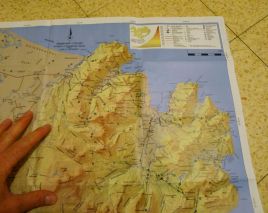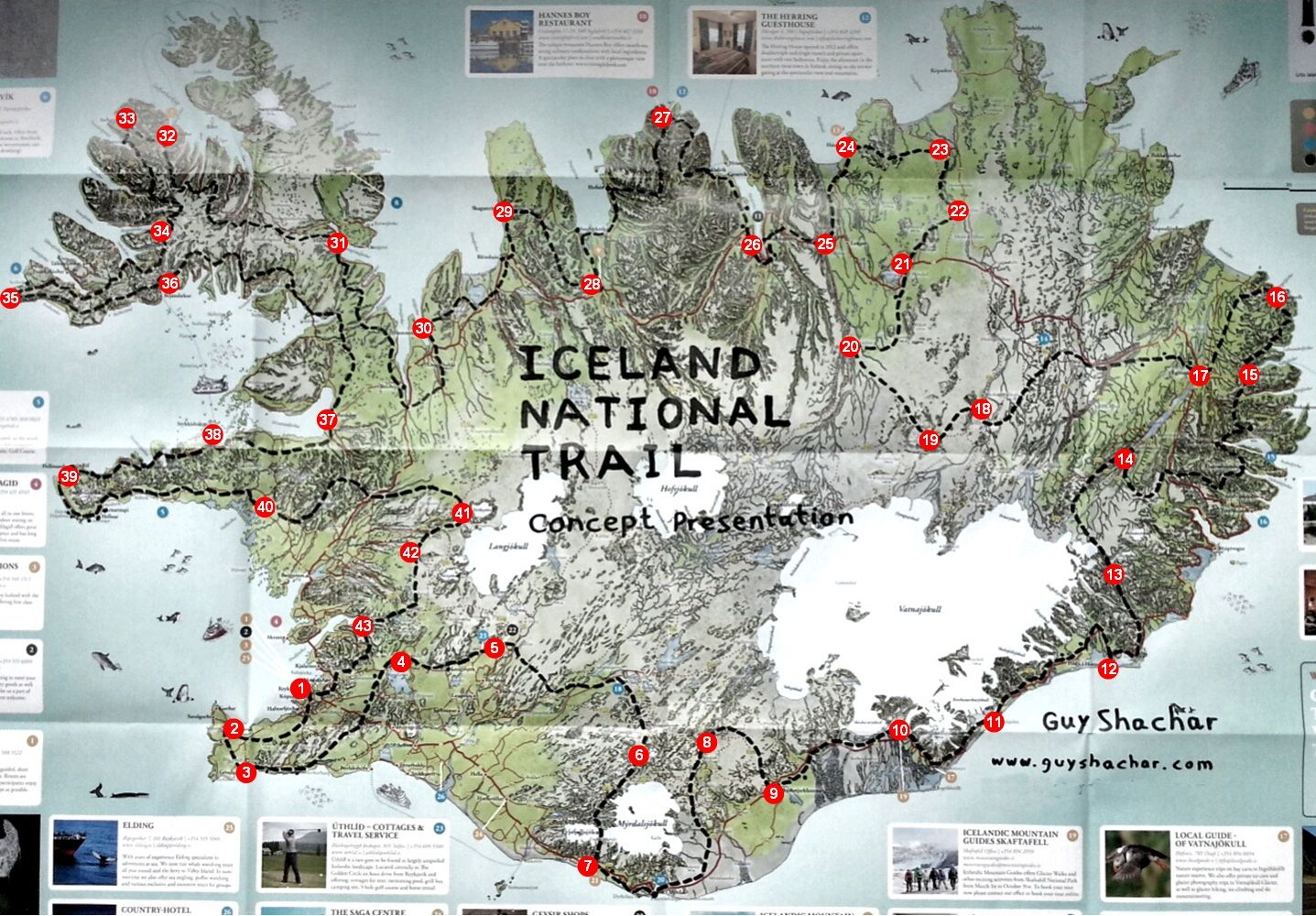Iceland National Trail is an initiative to create a long circular hiking & biking route that passes through Iceland’s best locations. Its main aim is to cope with the rapidly growing number of incoming tourists – spread tourism across the country, while providing added values to visitors such as encourage encounters between visitors and locals and bring tourism as a source of income to remote communities.
Motivation
I came up with the idea during a 40 days trip to Iceland in Summer 2013, while observing the large amount of tourists visiting Iceland, concentrating in a few touristic spots that are far from able to support the growing number of tourists.
In recent years the annual growth in number of incoming visitors to Iceland is exceeding 10%. If this trend continues, Iceland may face a serious crisis in providing proper infrastructure and services to tourists, as well as an environmental damage to highly visited spots.
I also witnessed the great contrast between wild nature and the remote communities that seem like a separate “layer” far from tourist eyes. Although accommodation is sometimes provided by families in farms, I felt that there’s much potential in bringing tourists and visitors closer. For tourists, it may be an important local experience. For locals, it may be a useful source of income and a refreshing “international” glimpse.
Furthermore, creating a long trail that stretches throughout the country may contribute to sense of place, serve as an infrastructure for culture, sport and environment activities, and provide a more organized and controlled framework for adventurers who seek long and extensive exploration. But such a trail is far from aiming at adventure tourism alone. With proper infrastructure, it may make hiking accessible for larger audiences, thus contribute to reduce the amount of “car tourism” that characterizes visits in Iceland, and bring tourists closer to nature.
Summary of advantages
- Spreading visitors throughout the country
- Diminishing stress on main touristic paths and sites
- Creating an incentive for additional visits
- Supporting remote areas
- Leveraging farms and small communities
- Reaching country gems – physical and cultural
- Creating a framework for a comprehensive visit
- Better control for adventure tourism while setting restricted areas
- Easing environmental pressure / spreading ecological footprint
- Branding – “Walk Iceland” / “See Iceland through your legs”
Implementation issues
Infrastructure
- Making nature more attractive/accessible for hiking for a broader span of people
- Provision of basic infrastructure along the trail such as emergency shelters, huts, camping places
- Creating standardization / minimum requirements for huts and campsites
- Defining sections where accommodation with beds + food supply are available to support a hut-to-hut hike, such as in Laugavegur trek
- Improving facilities in existing camping sites, especially better protection for rain / wind / low temperatures conditions
Planning and design
Due to the decentralized nature of bodies related to tourism and environment in Iceland, it is suggested that such a trail will be divided to sections that will be planned by local / regional communities, and supervised by a national committee with representatives from various relevant state level bodies.
A good example is Borgarfjörður Eystri, where local community identified the unique natural spots in its vicinity, planned and marked hiking trails, and issued the following fabulous map, creating an abundance of opportunities for exploration.
Thus, on the local / regional level it is suggested that municipalities and organizations will create work teams for designing and maintaining trails, as well as developing services for food, lodging, guidance & logistics by locals.
On a country level, it is suggested to create design workshops with landscape architects, ecologists, local residents and reserve & planning authorities for setting general guidelines, designing infrastructure elements that minimize ecological footp0rint, signs, marking, etc.
Snorri Þór Tryggvason from Borgarmynd commented that basing the trail on ancient trails (horse trails, sheep trails, “highways”) would make it much more interesting and increase its quality.
Initial sketch of a possible route
While using the great “Iceland Illustrated” paper edition map by BorgarMynd, I made an initial sketch of a possible route. The route of the trail links the main gems, existing trekking routes, cities and towns. It often crosses or passes by roads, for easier provision of infrastructure along the trail, and leaving remote areas ‘untouched’ (Note that it is only an initial suggestion that needs further thinking, surveying and planning!)
02 – Keflavík (Airport as another possible starting point)
03 – Grindavík
04 – Þingvellir
05 – Geysir
06 – Landmannalaugar & Laugavegur Trek
07 – Skógafoss
08 – Eldgjá & Laki
09 – Kirkjubæjarklaustur
10 – Skaftafell
11 – Jökulsárlón
12 – Höfn í Hornafirði
13 – Lónsöræfi Trek
14 – Lagarfljót
15 – East Fjords & Seyðisfjörður
16 – Borgarfjörður Eystri & trekking area
17 – Egilsstaðir
18 – Herðubreið
19 – Askja
20 – Aldeyjarfoss
21 – Mývatn
23 – Ásbyrgi & Hljóðaklettar
24 – Húsavík
25 – Goðafoss
26 – Akureyri
27 – Siglufjörður
28 – Varmahlíð
29 – Skagaströnd
30 – Hvammstangi
31 – Hólmavík
32 – Ísafjörður
33 – Suðureyri
34 – Dynjandi
35 – Látrabjarg
36 – Brjánslækur
37 – Búðardalur
38 – Stykkishólmur
39 – Hellissandur
40 – Eldborg
41 – Strutur
42 – Reykholt
43 – Hvalvatn
The trail is mainly intended for hiking, but since biking is favorite among visitors, it is suggested to include biking where possible along the trail with bypasses in sensitive / technically problematic areas.
Precedents
There are many examples for long trails around the world, some go through areas where terrain and climate create challenging conditions for travelers.
A good example is the Great Himalaya Trail – A more than 4,500km suggested long trail stretching the length of the Greater Himalaya range from India to Tibet. Its Nepal sections are basically established, linking well trodden trekking routes and new routes to form a continuous trail. Although some parts of that trail may be extremely challenging, the fact that the main long trail is defined makes it easier to support and supervise demand for adventure tourism, while providing means also for ‘average’ travelers to enjoy bits of such an experience, by hiking trail sections.
There are several famous long-distance trails in the United States, such as the 3,500km Appalachian Trail and the 10,900km(!) American Discovery Trail .
Israel National Trail is a 1,000km trek that traverses a variety of landscapes in Israel. Some parts of it traverse challenging areas of the desert. The trail was recently included in National Geographic list of “World’s Best Hikes”. Not only does the trail provide a unique exposure to a variety of physical formations, but it also takes hikers into various communities and provides opportunities for local cultural interactions.
In Iceland
Andrew Skurka traversed Iceland from east to west along a nearly 900 kilometers hike.
Many travelers seek adventures in Iceland trying to get into remote places, mainly in the highlands. In some cases, travelers are getting into trouble, unaware of challenging conditions. A designated specific trail may provide an opportunity to provide basic infrastructure for travelers such as emergency shelters and a better supervision on travelers.
Highlights of Iceland
Finally, here’s my photographed impression of Iceland’s highlights



2 Responses
Rosanne Luciana, London
Guy, I wanted to thank you for sharing your research here. I was very happy to find this ‘concept trail’, as I was searching for a suitable route to hike around the island, and found myself intrigued by this proposition. I plan on hiking a route this summer, based (as much as possible) on yours, minus the Westfjords, due to time and deteriorating weather conditions, mostly. I was wondering if you know of anyone who has attempted to hike the full proposed route yet? I would be very curious to see how others before have experienced it.
Ruth Aaqqii, East Greenland
Hi there! Has anyone hiked this route – or parts of it? I am planning to do a long hike in 2021. I am going to Iceland next months, to do some shorter hikes. If I enjoy it, I might try to attempt to hike around the island next summer! This is the only place on the internet I´ve found such a route presented. Now, this is years ago, by now, but I would love to hear from you, or Rosanne, or anyone else, about this. Thanks a lot for putting the map and suggestions out here.